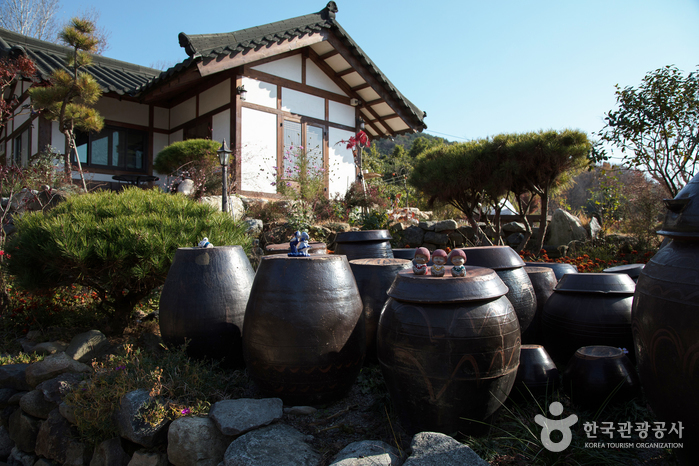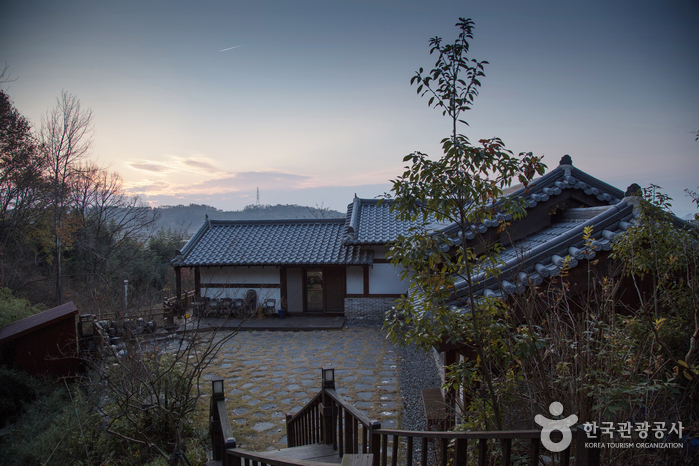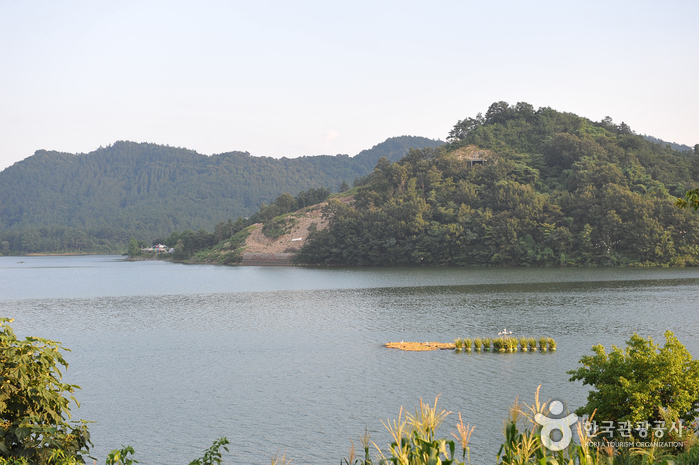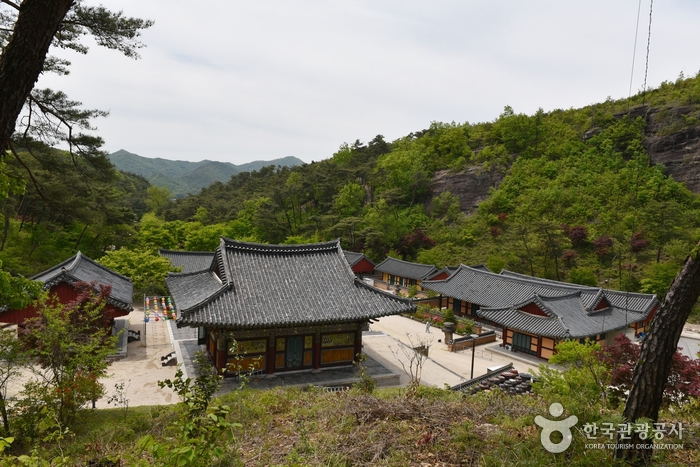Sane Flower ((주)산에는 꽃이피네)
4.0M 7470 2024-08-05
20-1 , Dongnyeok-gil, Naju-si, Jeollanam-do
+82-10-4612-4232
Mountain Flowers Bloom in Dorae Hanok Village, Naju-si, Jeollanam-do, is a 100 year-old house built in the traditional way using local timber and no nails. Guestrooms are well insulated and equipped with bathroom and kitchen. Interiors are lined with Korean paper and are old-time and cozy. There’s a wooden veranda from which visitors can see the fine old maple tree in the yard. Among other local attractions, Naju’s Redwood Road is nearby, offering guests a peaceful walk in the woods; some weekends, the owner offers neighbourhood guided tours.
Doraemi House (도래미)
147.5M 4415 2024-08-05
18-26 , Dongnyeok-gil, Naju-si, Jeollanam-do
+82-61-336-3646, +82-10-6604-6621
Doraemi House in Dorae Village, Naju, Jeollanam-do, is a hanok stay with a bonchae (‘main house’), a sarangchae (men’s house) and a byeolchae (‘reception room’). The bonchae has two bedrooms with a hidden attic space. The sarangchae has a living room with bedrooms on either side; while the byeolchae, atop a low hilll, has a single cozy room. A walk along a forest road takes you to a pavilion by a pond. Next to the bonchae is a quiet and tranquil reading room.
Maru-o [Korea Quality] / 마루오(MARU-O) [한국관광 품질인증]
4.1Km 212 2024-06-26
5-8 , Baemet 3-gil, Naju-si, Jeollanam-do
+82-61-331-0700
The Maru O Hotel is a business hotel in the heart of Naju Innovation City, Jeollanam-do, that has good facilities and is popular with both business travellers and tourists. The underground parking lot has an electric vehicle charging station, and both mobile phone chargers and tourist information for Naju and Jeonam is available at the front desk. Right in front of the hotel is Bitgaram Lake Park where visitors can take a pleasant walk. Naju KTX station and the Intercity Bus Terminal are 15 minutes away by car, and Naju’s Yeongsanpo Hongeo Street and Gomtang Street (famous for its restaurants!) are also nearby.
Naju Pear Museum (나주배박물관)
6.4Km 12648 2021-08-13
5838, Yeongsan-ro, Naju-si, Jeollanam-do
+82-61-339-2590
Known as the birthplace of Korean pears, Naju pears are well-known for its long history. The fruit was exported worldwide starting in 1967. The Naju Pear Museum promotes the fruit and is a learning center for its agricultural history. The museum opened on April 20, 1992 and is the world's only pear museum.
Najuho Lake (나주호)
6.7Km 30275 2021-05-24
Bangsan-ri, Naju-si, Jeollanam-do
+82-61-339-8591
Najuho Lake is a man-made reservoir that holds about 91 million tons of water. Najuho Lake spans across Panchon-ri, Gungwon-ri and Bangsan-ri in Dado-myeon. The dam that created the lake was completed in 1976 and is about 496 meters in length. The lake is a favored vacation and fishing site, with beautiful scenery and abundance of freshwater fish. Nearby attractions include temples, forests and a golf course.
Chojeom Stay [Korea Quality]스테이 초점[한국관광 품질인증]
6.8Km 2 2023-05-23
33-6 , Dangga-gil, Naju-si, Jeollanam-do
+82-10-4892-3473
Chojeom Stay is a hanok guesthouse in the innermost part of a small village in Naju, Jeollanam-do. The old house, which has been renovated, comprises a living room, kitchen, bedroom space and a raised-floor numaru where guests can enjoy a quiet hour while brewing tea. The spacious yard contains an outdoor fire place that creates a sentimental time, and an open-air tub where you can bathe in warm water while cool breezes rustle the trees. The outdoor shoes lined up by the side of the yard are somehow touching.
YangDongHo Traditional House (Hanok 152) [Korea Quality] / 양참사댁(양동호 가옥 / 한옥152) [한국관광 품질인증]
8.0Km 173 2020-12-10
24, Darasil-gil, Hwasun-gun, Jeollanam-do
+82-10-9646-5087
Yangchamsadaek (Yangdongho’s former name) or National Cultural Property No. 152 is a traditional hanok accommodation. Dalasil Village, Hwasun, Jeollanam-do, where the house is located, is a town with traditional houses and fields, where interestingly those who have the surname of Jeju Yang live together.
Yangchamsadaek is a typical noble's house in the southern region with the ㄷ-shaped main building and the ㅡ-shaped detached building form the ㅁ shale. It is expected that the main building was built in the 18th century and the detached building at the end of 19th century. In 2013, the current owner has taken over the antique house and started running a hanok stay, and his daughter, Jo A-ae, a curator and culture planner, added modern touches to turn it into a culture complex, Hanok 152. The wide lawn is sometimes rented for music performance, traditional wedding, or outdoor wedding, and other times it serves as a venue of one-day classes for hanbok experience, Korean food experience, etc.
As for rooms, there are four options: big room and small room in Anchae (main building), and Daecheong room and bed room in Sarangchae (detached building). The rooms are decorated with traditional cabinets and folding screens with embroidery, displaying the beauty of an antique house. The main floor, which is much bigger than that of other houses, has been renovated by the owner. The main floor in the main building, with a comfortable sofa and a rug, is modern and luxurious, whereas the main floor in the detached building is cozy with a floor table and Korean cushions. Toiletries are not available in the bathroom but provided upon request to the information desk. Space rental is also available. Various events such as traditional wedding, small wedding, first birthday celebration, 70th birthday celebration, small workshop, or one-day class can be held here. Moreover, traditional hanbok experience is always available at 15,000 won per person. Korean food experience is notified on Instagram and requires reservation. As the cost varies depending on the number of participants and the date, make sure to inquire over the phone.
Also located in the village are Hanjae House (National Cultural Property No. 154) and World Heritage Hwasun Dolmen Site. Note that the Unjusa Temple, famous for the Cheonbulcheontap Pagoda, is a 15-minute drive away.
Hwasun Dolmen Site [UNESCO World Heritage] (화순 고인돌군 유적 [유네스코 세계문화유산])
8.5Km 21624 2020-06-04
Goindol 1-ro, Hwasun-gun, Jeollanam-do
+82-61-379-3178
The Hwasun Dolmen Site is located near the waterfalls of the mountain pass linking Dogok-myeon of Hyosan-ri and Chunnyang-myeon of Daesin-ri. According to experts, 135 of the 980 stones in Dogok-myeon Hyosan-ri are dolmen. There are also about 100 damaged stone tables that still maintain their original form.
What makes the Hwasun dolmens special is that in such a small district there are as many as 596 dolmen, including Korea’s biggest stone table.
Acknowledging the importance of the cultural assets, the Hwasun Dolmen Site was registered as World Heritage No. 997 in year 2000 along with Gochang and Ganghwa Dolmens.
Yeongsangang River Culture Pavilion (영산강문화관)
9.3Km 432 2020-06-09
90, Seungchonbo-gil, Nam-gu, Gwangju
+82-62-335-0866
With the slogan “Yeongsangang River, where Nature and Life Coexist,” Yeongsangang River Culture Pavilion consists of an open space that blends well with the surrounding natural environment. The center provides a variety of educational programs and hands-on events, through which visitors can increase their understanding of the Yeongsangang River restoration project, the history of Namdo region, and the cultural and ecological environment of the area.
Unjusa Temple (운주사)
9.6Km 24164 2022-07-25
91-44, Cheontae-ro, Hwasun-gun, Jeollanam-do
+82-61-374-0660
Unjusa Tmeple was called Bibosa Temple during the late Silla Period. However, during excavation work that took place between 1984 and 1989, it was discovered to have been built long before that during the early Goryeo period. The temple fell into disrepair after the Imjin War (1592-1598), but was partly restored in the 1800s by Monk Seoldamjau. Unjusa Temple’s famous heritages include the Nine-story Stone Pagoda (Treasure No. 796), Shrine of Stone Buddha (Treasure No. 797), and Cylindrical Multi-story Stone Pagoda (Treasure No. 798).


![Maru-o [Korea Quality] / 마루오(MARU-O) [한국관광 품질인증]](http://tong.visitkorea.or.kr/cms/resource/14/2593514_image2_1.jpg)

![Chojeom Stay [Korea Quality]스테이 초점[한국관광 품질인증]](http://tong.visitkorea.or.kr/cms/resource/05/2949005_image2_1.jpg)
![YangDongHo Traditional House (Hanok 152) [Korea Quality] / 양참사댁(양동호 가옥 / 한옥152) [한국관광 품질인증]](http://tong.visitkorea.or.kr/cms/resource/23/2594823_image2_1.jpg)
![Hwasun Dolmen Site [UNESCO World Heritage] (화순 고인돌군 유적 [유네스코 세계문화유산])](http://tong.visitkorea.or.kr/cms/resource/03/2515703_image2_1.jpg)


 English
English
 한국어
한국어 日本語
日本語 中文(简体)
中文(简体) Deutsch
Deutsch Français
Français Español
Español Русский
Русский